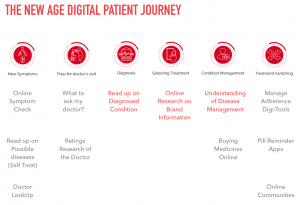20 Jul The Digital Patient
Doctors have changed and so have patients. I still recall going to a doctor in the earlier days, waiting in a long line of patients who discussed what was wrong with them. It used to be a place to meet uncles and aunties from the area and catch up on what was happening in and around. The wooden partition between the patient and the doctor and the curtain between the doctor and his compounder. The paper packets of tablets and small plastic bottles with red syrups. Going back home, clueless on what the doctor said and blindly following his advise until you get better.
We are now digital patients.
A digital patient is someone who goes online to search for his symptoms. It could be an unusual headache, a tingling feeling in his foot, a stomach upset or even a dizzy feeling in the middle of the day, sometimes these can go as drastic as seeing blood in urine and still instead of dialing the closest doctor they fish out their smartphones.
Ongoing through a quick search and sometimes an online test of Yes’s/ No ’s, rating 1 to10, or clicking radio buttons a-b-c.
Quick conclusions are drawn and we don’t delay reading about what it is and many a time assuming the worst.
The digital patient then starts reading about the disease. From WebMD to Wikipedia, suddenly they scan through everything. We call it the Half Doctor Syndrome.
Now we need a doctor to only reconfirm our findings.
So we log on again to doctor listing sites across the web and around our locality. We are ready to travel a few miles for the best doctor even though they could be a decent one around your vicinity too.
Not only do they search for the doctor, but they also want to read reviews, and know more about his history and qualifications and expertise. We want to see what other patients say about the doctor and if he has any issues or cases against him.
Great, we narrowed down on the doctor. But instead of calling the doctor, we will also take an appointment with him online. A few clicks and it’s done.
Preparing for the doctor’s visit is not route planning only but also what to ask the doctor. Quick sets of questions are typed in the notes app of the phone. It could be serious to frivolous and the digital patient doesn’t care. He wants the bang for his buck.
The doctor appointment could sometimes start with “I have this particular disease!!” I know for a fact that this would make any doctor furious but doctors have learned to stay calm and ask the patient to explain his symptoms.
Now sometimes patients would’ve gone to a diagnostic lab earlier itself and tried to confirm their suspicion with a test and they will not hesitate to show the reports to the doctor. Much to their dismay…
So does the journey end here. Well No!

The patient gets probably a new diagnosis, and he is back to the information sites reading about his disease. But now he is also armed with a prescription and a list of medicines, tests, sometimes a monitoring device, a medical equipment, or a procedure.
Not taking things lying down are we?
We read about the medicine in depth, the uses, the indication, the manufacturer, the marketer, the price, the detailed information.
He also clicks a picture of his prescription and keeps in it in the gallery, just in case he needs it at any point of time. He will soon look for places where he can upload, digitize and save these pieces of information which could be used in the future.
There is a serious need for pharma and healthcare brands to improve their online reputation because when the digital patient searches for a brand online all he sees is uses, side effects, contraindications, drug-drug interactions etc. Basically, the prescribing information that doctors read or pack inserts which is statutory information.
Patients would also like to read about the brand’s credibility, efficiency, and USPs. These could be the quality of manufacturing, patents, usefulness, and so many credible features, advantages, and benefits.
The digital patient now moves ahead, he buys the medicines online, looks for coupon codes, searches for bargains and expects quick and authentic delivery.
He also looks for pill reminder apps and is dependent on them for adherence.
Not easily satisfied, the digital patient tries to reconfirm his condition with a second opinion.
In the case of chronic diseases, the digital patient wants to join online communities, get continuous updates, signs up for restocking medicines with e-pharmacies.
This Impatient generation can’t wait for a website for more than 6 seconds to load, how do you expect them to wait for a treatment to begin in 3 days? They expect quick results and want to stay in touch with their doctor, ask him questions, WhatsApp him, email him and they do it with no reluctance.
This goes on till a level of satisfaction is received.
As they say, the healthcare world has moved from influencer based to information based. The patient is powerful and we need to start understanding this as soon as possible and be ready for the change.
We take one step ahead, with our initiative therxreviewer.com . TheRxReviewer is a web directory of prescriptive brands that will help the medical fraternity access details about pharmaceutical brands and help get more information on the molecule or formulation, from authentic sources. The purpose of this site is to ‘enhance the confidence in the prescription’ by providing accurate, relevant, unbiased, objective medical facts. TheRxReviewer does not compare, endorse, advocate or rate brands. We strongly discourage substitution and self-medication.
Hey digital patient, and hey digital doctor, and hey digital marketer… log on to www.therxreviewer.com




